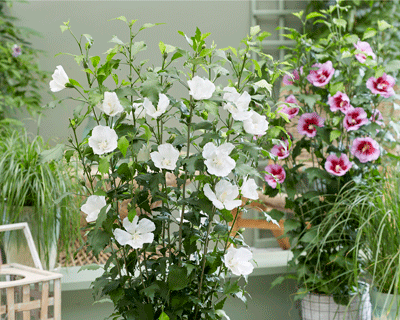New plants: Hibiscus Flower Tower Series
Ideal for small gardens, these three narrow, upright Hibiscus are the first of their kind. They grow well in pots, make a great hedge, and provide sculptural statements in sunny borders
Enter this ground-breaking trio of tree mallows: the Flower Tower Series. Instead of maturing into a rounded shape, these new cultivars develop a pyramidal form. A two-year-old containerised plant is likely to reach 98cm high with a 44cm spread; eventually maturing at 3m high by only 80cm wide.
Flower Tower Hibiscus provide a long succession of sterile flowers through summer and autumn
The Flower Tower Series comes in three tempting colours. Flower Tower Ruby ('Gandini van Aart Ruby') is a rich pinkish red, with a blood-red eye to the flower. Flower Tower White ('Gandini van Aart') is a stunning pure white, but perhaps the prettiest of all is Flower Tower Purple ('Gandini Santiago'), with bicolored flowers in reddish pink, with a rich reddish purple zone at the throat that becomes feathered towards the edges.From a chance find on a Spanish nursery to our gardens
It had a more pronounced double flower, in a new colour, and most importantly, the plant had developed an upright, pillar-like habit. Andres took
The nursery subsequently closed, but by this time Andres’ sport was being grown at the Gandini nursery in Italy, where it was used as a rootstock onto which other varieties were grafted. Its full potential was rediscovered by visiting Dutch growers, who took it back to The Netherlands for a formal trial. The qualities of Andres' sport were recognised, and the sport was named 'Gandini Santiago' or Flower Tower Purple.
Ten years after the initial discovery, a sport with pure white flowers was found on a container-grown plant at the Dutch nursery. This became Flower Tower White.


